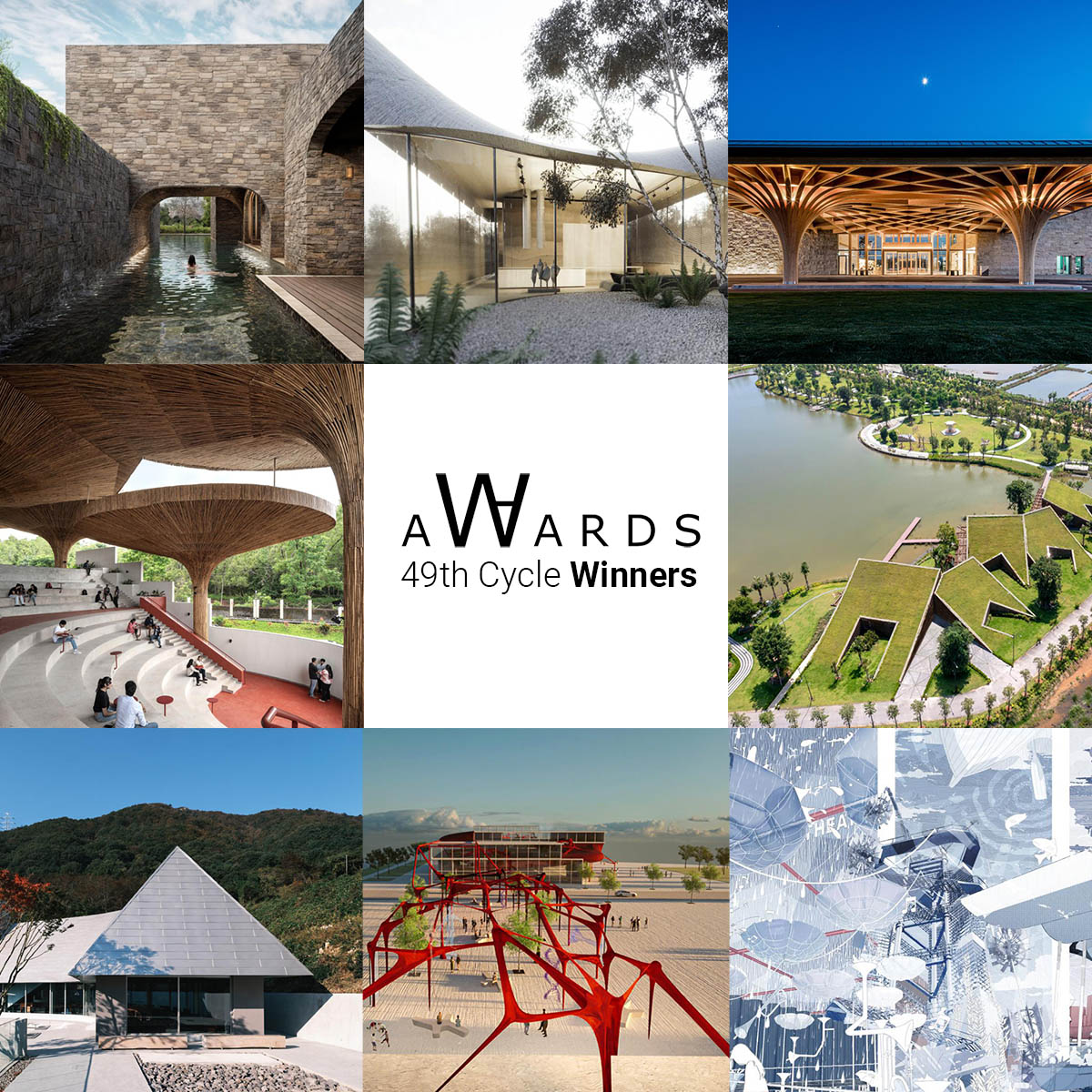WORLDARCHITECTURE.ORG
World Architecture Community Awards 49th Cycle winners are announced
html PUBLIC "-//W3C//DTD HTML 4.0 Transitional//EN" "http://www.w3.org/TR/REC-html40/loose.dtd"The World Architecture Community has announced the winners of WA Awards 10+5+X 49th Cycle in Architecture, and Student categories.We have 34 different winning projects from 18 different countries with a fantastic mix of building types, spanning from Iran, South Korea, Colombia, Finland, Saudi Arabia to Slovenia, Japan, United Kingdom.In short, the winning countries can be listed as Turkey, Japan, Slovenia, United Arab Emirates, India, Iran, Vietnam, Spain, South Korea, China, Saudi Arabia, Netherlands, Finland, Oman, Palestine, Colombia, United Kingdom, and Bangladesh.Akshay Heranjal's Center For Inclusive Growth & Competitiveness For TAPMI in India won the WA Award in the 49th Cycle in the Architecture/Realised category. Image SURYAN //DANGWA Awards 10+5+X 49th Cycle Architecture/Realised categoryIn the Architecture/Realised category, Akshay Heranjal's project; Center For Inclusive Growth & Competitiveness For TAPMI in India, MIA Design Studio's The Park in Vietnam, Schiattarella Associati's Diriyah Art Futures. Riyadh, Saudi Arabia, Pablo Gil's House On The Cliff in Spain are among the winners of the WA Awards 49th Cycle.In addition, Babak Hassanpour's Adib Apartment in Iran, YKH Associates' Hillmaru Country Club in South Korea, Sungho Ko's SEONYUDOWON in South Korea were awarded by the Votings of WAC Community Members in the Architecture/Realised category.Scroll down for the winning Architecture/Realised projects below:- Selected by the votes of Honorary Members and Winners in earlier cycles (10 projects)Center for Inclusive Growth & Competitiveness for TAPMI, India, by Akshay HeranjalAdib Apartment, Iran by Babak HassanpourThe Park, Vietnam, by MIA Design StudioHouse on the Cliff, Spain, by Pablo GilHillmaru Country Club, South Korea, by YKH AssociatesCHILAMSAGYE, South Korea, by Sungho KoHubei Three Gorges Resettlement Museum, China, by Dongzhu ChuSes Veles Puigpunyent, Spain, by Joan FortunySunglim Mokjang, South Korea, by Sungho KoDiriyah Art Futures. Riyadh, Saudi Arabia, Saudi Arabia, by Schiattarella Associati- Selected democratically, through the votings of community members (+5 projects)Adib Apartment, Iran by Babak HassanpourHouse on the Cliff, Spain, by Pablo GilHillmaru Country Club, South Korea, by YKH AssociatesYeongJongDo Onnuri Church, South Korea, by Hyung-Chul ShinSEONYUDOWON, South Korea, by Sungho KoYazgan Design Architecture's Ayvalk Stone House in Turkey won the WA Award in the 49th Cycle in the Architecture/Realised category. Image Yazgan Design ArchitectureWA Awards 10+5+X 49th Cycle Architecture/Designed categoryIn the Architecture/Designed category, Yazgan Design Architecture's Ayvalk Stone House in Turkey, Sanjay Puri Architects' Earth Home in India, Ghasem Navaei's Dubai Seahouse in United Arab Emirates, Meysam Feizi's Laanak Villa in Iran are among the winners of the WA Awards 49th Cycle. These winning projects were selected by the Votes of Honorary Members and Winners in earlier cycles.GK Archi's Calla Garden 2 in Vietnam, ROOM+ Design & Build's Leaning House in Vietnam, Ghasem Navaei's Malek-Cheshme Therm in Iran were awarded by the Votings of WAC Community Members in the Architecture/Designed category.Scroll down for the winning Architecture/Designed projects below:- Selected by the votes of Honorary Members and Winners in earlier cycles (10 projects)Ayvalk Stone House, Turkey, by Yazgan Design ArchitectureMalek-Cheshme Therm, Iran, by Ghasem NavaeiLaanak Villa, Iran, by Meysam FeiziEarth Home, India, Sanjay Puri ArchitectsPassive house blessed with sun space for grapevine, Japan, by Kikuma WatanabeRhythm Ankara, Turkey, by ACE ArchitectureCalla Garden 2, Vietnam, by GK ArchiRoute Home, Slovenia, by Anton ZizekDubai Seahouse, United Arab Emirates, by Ghasem NavaeiRe-walled, Iran, by Mohammadjavad Abdolhoseini- Selected democratically, through the votings of community members (+5 projects)Ayvalk Stone House, Turkey, by Yazgan Design ArchitectureMalek-Cheshme Therm, Iran, by Ghasem NavaeiLaanak Villa, Iran, by Meysam FeiziCalla Garden 2, Vietnam, by GK ArchiLeaning House, Vietnam, by ROOM+ Design & BuildSantiago Caballero Barrios' The School In The Park in Colombia won the WA Award in the 49th Cycle in the Architecture/Student category. Image courtesy of Santiago Caballero BarriosWA Awards 10+5+X 49th Cycle Architecture/Student categoryIn the Architecture/Student category, Elif Ertemiz's Harbour Metabolism in the Netherlands, Luan Fontes' Force of Nature: Helsinki Design Museum in Finland, Santiago Caballero Barrios' The School in the Park in Colombia, Xinyue Geng's Let's Play! - A Journey Of Regeneration And Reconnection In Glasgow are among the winners of the WA Awards 49th Cycle. These winning projects were selected by the Votes of Honorary Members and Winners in earlier cycles.Additionally, Feride Ege's Collaborative Health Nexus Museum in Turkey, Abdul Mateen's Weaving Nizwa in Oman, Nusrat Nasrin Ananna's Unveiling Biodiversity: A Natural History Museum Complex for Discovering the Treasures of Bangladesh were awarded by the Votings of WAC Community Members in the Architecture/Student category.Scroll down for the winning Architecture/Student projects below:- Selected by the votes of Honorary Members and Winners in earlier cycles (10 projects)Harbour Metabolism, the Netherlands, by Elif ErtemizCollaborative Health Nexus Museum, Turkey, by Feride EgeForce of Nature: Helsinki Design Museum, Finland, by Luan FontesWeaving Nizwa, Oman, by Abdul MateenSocial Factory: Basmane, Turkey, by Zeynep DemircanRight to Dwell: Rethinking Refugees Shelter Design, the Case of Al-Zaatari Camp, Palestine, by Ruba AbuGheithThe School in the Park, Colombia, by Santiago Caballero BarriosLet's Play! - A Journey Of Regeneration And Reconnection, Glasgow, by Xinyue GengReviving Old Cairo, United Arab Emirates, by Rawan KhedrLayered-Void Hub: Void's Evolution Layers Unveiling Transformation, Turkey, by Hakan ahin- Selected democratically, through the votings of community members (+5 projects)Collaborative Health Nexus Museum, Turkey, by Feride EgeWeaving Nizwa, Oman, by Abdul MateenSocial Factory: Basmane, Turkey, by Zeynep DemircanReviving Old Cairo, United Arab Emirates, by Rawan KhedrUnveiling Biodiversity: A Natural History Museum Complex for Discovering the Treasures of Bangladesh, Bangladesh, by Nusrat Nasrin AnannaOne Cycle ends as another starts...With this announcement, we'd like to remind you that the 50th Cycle of WA Awards is now open for submissions. You can submit your entries until31 March2025 (23:59 GMT +0).If you also want your project to get the recognition it deserves, make sure to participate before the deadline is over.Your starting point is How to Participate page. Read more about WA Awards 10+5+X.Top image in the article (from left to right): Yazgan Design Architecture's Ayvalk Stone House ( Yazgan Design Architecture), Meysam Feizi's Laanak Villa (Iman Panahi), YKH Associates' Hillmaru Country Club (Dongwook Jung), Akshay Heranjal's Center For Inclusive Growth & Competitiveness For TAPMI ( SURYAN //DANG), MIA Design Studio's The Park (Chien Trieu), Sungho Ko's Sunglim Mokjang ( Dohwa Kang), Feride Ege's Collaborative Health Nexus Museum ( Feride Ege), Xinyue Geng's Let's Play! - A Journey Of Regeneration And Reconnection In Glasgow ( Xinyue Geng).








